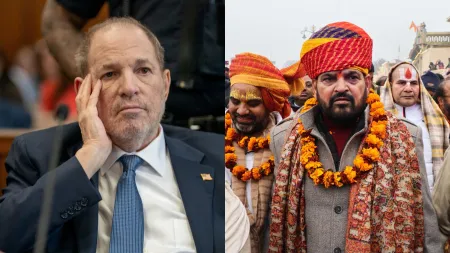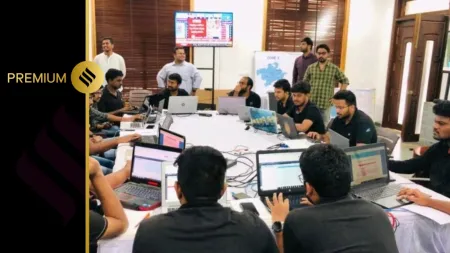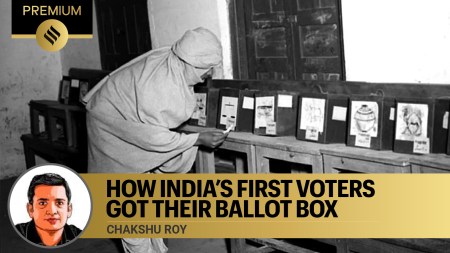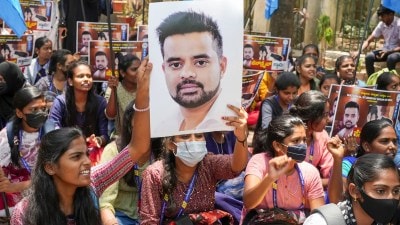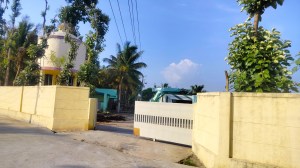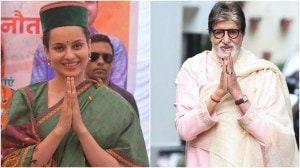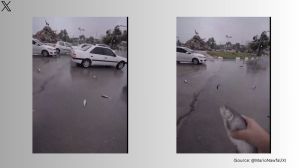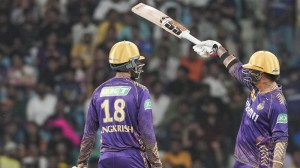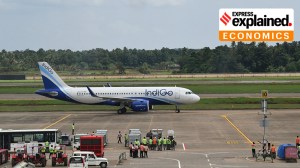- India
- International
UPSC Weekly Current Affairs Quiz | April 14 to April 20, 2024
Brush up your current affairs knowledge with this week's top 15 questions and consolidate your UPSC-CSE preparation. Find answers along with explanations at the end of the quiz.
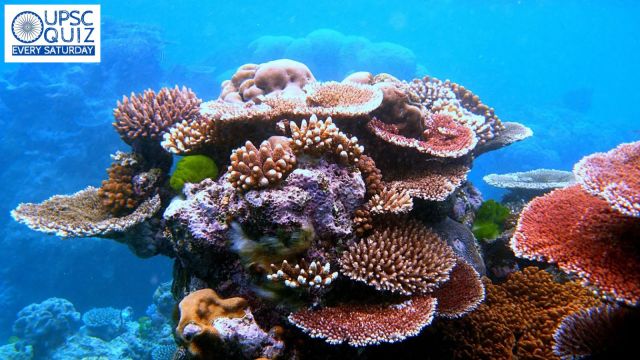 A variety of corals form an outcrop on Flynn Reef, part of the Great Barrier Reef near Cairns, Queensland, Australia, in 2010. Find a question on corals in today's quiz. (Photo: Wikimedia Commons)
A variety of corals form an outcrop on Flynn Reef, part of the Great Barrier Reef near Cairns, Queensland, Australia, in 2010. Find a question on corals in today's quiz. (Photo: Wikimedia Commons)UPSC Weekly Quiz is a current affairs-based quiz on relevant topics from the past week, curated for the aspirants of competitive examinations. Attempt the weekly quiz every Saturday and find answers to the MCQs with explanations at the end of the article.
🚨 The Indian Express UPSC Essentials brings to you the April edition of its monthly magazine. Click Here to read. Share your views and suggestions in the comment box or at manas.srivastava@indianexpress.com🚨
QUESTION 1
With reference to the BrahMos missile, consider the following statements:
1. It is a two-stage missile with a solid propellant booster engine.
2. The missile has a very low radar signature which makes it stealthy.
3. The course of the missile cannot be altered once fixed.

4. There is no sea to sea variant of BrahMos missile.
How many of the statements given above are correct?
(a) Only one
(b) Only two
(c) Only three
(d) All four
QUESTION 2
Consider the following:
1. Manimekalai
2. Thirukkural
3. Silappadhikaram
4. Tolkappiyam
How many of the above are written by Thiruvalluvar?
(a) Only one
(b) Only two
(c) Only three
(d) All four
QUESTION 3
With reference to the Model Code of Conduct (MCC), consider the following statements:
1. The MCC was first introduced in the state assembly elections in Kerala.
2. It is a set of rules established to govern political parties and candidates before of elections.
3. It does not contain provisions dealing with election manifestos.
4. It comes into force from the date the election schedule is announced.
How many of the statements given above are correct?
(a) Only one
(b) Only two
(c) Only three
(d) All four
QUESTION 4
Consider the following:
1. Fallopian tube blockage
2. Ovulatory dysfunction
3. Endometriosis
How many of the above are the common causes of infertility?
(a) Only one
(b) Only two
(c) All three
(d) None
QUESTION 5
Consider the following states:
1. Odisha
3. Jharkhand
4. West Bengal
How many of the above states are covered under Mahanadi river basin?
(a) Only one
(b) Only two
(c) Only three
(d) All four
QUESTION 6
PAC-2 and PAC-3 were recently in news. They are associated with:
(a) Medium-range air defence system
(b) Short-range air defence system
(c) Anti-ballistic missiles
(d) Air defence systems that can intercept a range of missiles and target aircraft and drones
QUESTION 7
Which of the following statements is not correct about corals?
(a) They are essentially animals which attach themselves to the ocean floor.
(b) They are referred to as rainforests of the sea.
(c) They provide economic goods and service.
(d) They are not sensitive to light and temperature.
QUESTION 8
With reference to the India’s trade with Israel and Iran, consider the following statements:
1. The trade between India and Israel is doubled from 2018-19 to 2022-23.
2. Diesel and diamonds account for around 80% of total exports from India to Israel in 2022-23.
3. India’s trade with Iran has decreased in 2022-23 as compared to 2021-22.
4. India’s export value to Iran is smaller than its imports from Iran.
How many of the statements given above are correct?
(a) Only one
(b) Only two
(c) Only three
(d) All four
QUESTION 9
Shahid Beheshti port was recently in news. It is located in:
(a) Bangladesh
(b) Myanmar
(c) Iran
(d) Oman
QUESTION 10
With reference to the Nagara style of temple architecture, consider the following statements:
1. The Nagara style of temple architecture emerged during the late Gupta period.
2. In these temples, circumambulatory passage around the garbha griha is absent.
3. Shikhara is the most distinguishable aspect of Nagara style temples.
4. These temples are built on a raised plinth.
How many of the statements given above are correct?
(a) Only one
(b) Only two
(c) Only three
(d) All four
QUESTION 11
With reference to ‘cloud seeding’ consider the following statements:
1. It is a process of spraying salt mixtures in clouds.
2. The process is used in places with heavy rainfall which eventually decreases precipitation.
Which of the above statements are true?
(a) 1 only
(b) 2 only
(c) Both 1 and 2
(d) Neither 1 nor 2
QUESTION 12
With reference to Indian Monsoons consider the following statements:
1. According to the IMD, rainfall between 96 per cent and 104 per cent of the 50-year average (1971-2020) is considered “normal”.
2. Rains during the June-September monsoon season accounts for 75 per cent of India’s annual rainfall.
Which of the statement(s) given above is/are correct?
(a) 1 only
(b) 2 only
(c) Both 1 and 2
(d) Neither 1 nor 2
QUESTION 13
With reference to Longevity India Initiative, consider the following statements:
1. It is launched by Niti Aayog and WHO
2. It aims at increasing human healthspan and overcoming challenges associated with growing older.
Which of the above statements is/are not correct?
(a) 1 only
(b) 2 only
(c) Both 1 and 2
(d) Neither 1 nor 2
QUESTION 14
With reference to the indelible ink, a lasting symbol of Indian elections, consider the following statements:
1. The Representation of the People Act (RoPA) of 1951 mentions the ink.
2. Indelible ink contains silver nitrate which is a colourless compound which becomes visible when exposed to ultraviolet light, including sunlight.
3. The indelible ink was first manufactured at the ECI’s request by the government’s Council of Scientific & Industrial Research (CSIR).
How many of the above statements are correct?
(a) Only one
(b) Only two
(c) All three
(d) None
QUESTION 15
David’s Sling was recently seen in news. It is:
(a) An economic indicator for unemployment
(b) A defence system used in wars
(c) A geographical phenomenon which is often seen dry summer spells
(d) A new tool for the accuracy of umpiring in the game of cricket.
ANSWERS TO THE MCQs
1. (b)
FYI:
— India’s BrahMos supersonic cruise missiles were delivered to the Philippines, as part of a $375 million deal signed by the two countries in 2022.
— BrahMos is a two-stage missile with a solid propellant booster engine. Its first stage brings the missile to supersonic speed (meaning faster than sound) and then gets separated. The liquid ramjet or the second stage then takes the missile closer to three times the speed of sound in cruise phase. Hence, statement 1 is correct.
— The missile has an extremely low radar signature, making it stealthy, and it can follow a variety of paths. To hit the target, the ‘fire and forget’ missile can fly at a cruising height of 15 km and a terminal altitude of 10 m. Hence, statement 2 is correct.
— The BrahMos has three times the speed, 2.5 times the flying range, and a longer range than subsonic cruise missiles.
— The missile’s course can be altered by moving these controlling surfaces. Hence, statement 3 is not correct.
— In 2022, a frontline SU-30MKI aircraft flew an extended-range version of the BrahMos air-launched missile. The same year, an improved sea-to-sea variant of BrahMos was tested at INS Visakhapatnam. Hence, statement 4 is not correct.
Therefore, option (b) is the correct answer.
2. (a)
FYI:
— Dravidian literature is mostly composed of the four languages Tamil, Telugu, Kannada, and Malayalam. Tamil is the oldest language that has retained its Dravidian flavour the most. Kannada, as a cultural language, is nearly as ancient as Tamil.
— The Sangam classics, which include 18 works (eight anthologies of lyrics and ten lengthy poems), are renowned for their directness of language.
— To better understand early Tamil poetry, a Tamil grammar book called Tolkappiyam was written during the period.
— The twin epics, Silappadhikaram (the narrative of the anklet) by Ilango-Adigal and Manimekalai (the story of Manimekalai) by Chattanar, were composed between A.D. 200 and 300 and provide detailed descriptions of Tamil culture at the time.
— Thiruvalluvar, also known as Valluvar in Tamil, has long been recognised as a Tamil cultural and moral symbol, adored by Tamils of all castes and religions as an ancient saint, poet, and philosopher.
— The ‘Thirukkural’, a compilation of 1,330 couplets (‘kurals’ in Tamil), is an integral element of every Tamil home, just as the Bhagavad Gita and Ramayana/Ramcharitmanas are in traditional North Indian Hindu households.
— Thiruvalluvar, the author of the renowned Tamil classic Kural, wrote an advise for the monarchs of the Sangam age, warning them about the corrupting influence of unrestrained power.
Therefore, option (a) is the correct answer.
3. (b)
FYI:
— The Election Commission’s Model Code of Conduct is a set of guidelines issued to regulate political parties and candidates prior to elections. Hence, statement 2 is correct.
— According to the Press Information Bureau, a version of the MCC was first introduced in the state assembly elections in Kerala in 1960. Hence, statement 1 is not correct.
— In October 1979, the EC added a section to regulate the ‘party in power’ and prevent it from gaining an unfair advantage at the time of elections.
— The MCC comes into force from the date the election schedule is announced until the date that results are out. Hence, statement 4 is correct.
— The MCC contains eight provisions dealing with general conduct, meetings, processions, polling day, polling booths, observers, the party in power, and election manifestos. Hence, statement 3 is not correct.
Therefore, option (b) is the correct answer.
4. (c)
FYI:
— IVF includes a range of procedures, through which a woman’s mature egg cells are removed from her body and fertilised with a male sperm cell. Then, implantation of the fertilised cell or the zygote happens in the mother or the surrogate woman’s uterus for pregnancy to begin.
— The common causes of infertility include medical reasons like fallopian tube blockage, ovulatory dysfunction, endometriosis, etc, in women and poor sperm quantity or quality in men.
— The other important cause for infertility includes lifestyle issues such as increasing marital age, postponement in childbearing, stress, consumption of alcohol and tobacco, besides unhealthy diet.
Therefore, option (c) is the correct answer.
5. (c)
FYI:
— A boat carrying them capsized in the Mahanadi River in Odisha’s Jharsuguda district, killing one and leaving seven people missing.
— The Mahanadi basin covers the states of Chhattisgarh and Odisha, as well as lesser areas of Jharkhand, Maharashtra, and Madhya Pradesh, and drains an area of 1,41,589 Sq.km, or roughly 4.3% of the country’s entire geographical area.
— It is bounded by the Central India hills to the north, the Eastern Ghats to the south and east, and the Maikala range to the west.
— The Mahanadi River originates in a pool 6 kilometres from Farsiya village in Chhattisgarh’s Dhamtari district. The river runs for 851 kilometres from its source to its mouth in the Bay of Bengal.
Therefore, option (c) is the correct answer.
(Other Source: indiawris.gov.in)
6. (d)
FYI:
— Israel’s air defence system is meant to provide multi-layered defences against a range of aerial threats, which includes aircraft, cruise and ballistic missiles as well as unmanned aerial vehicles (UAVs).
— Arrow System: Anti-ballistic missiles, capable of intercepting long-range missiles. Developed in collaboration with the US. Arrow-2 can intercept ballistic missiles within the atmosphere. Arrow-3 has the capability of intercepting missiles outside the Earth’s atmosphere.
— David’s Sling (or Stunner): Israel’s medium-range air defence system, which can intercept cruise missiles, ballistic missiles, and aircraft. Its range is 300 kilometres.
— Iron Dome: Israel’s indigenous short-range air defence system which can intercept rockets, artillery shells, and mortar bombs. Its range is 70 kilometers.
— Patriot PAC-2 and PAC-3: The US-made Patriot PAC-2 and PAC-3 are air defence systems that can intercept a range of missiles and target aircraft and drones.
— Spyder: Family of multi-range mobile air defence systems to defend large areas against aerial attack. It’s an all weather system and can be activated within seconds of the target being declared hostile.
— Israel is developing the Iron Beam to intercept incoming threats with laser technology. It is yet to be fully operational.
Therefore, option (d) is the correct answer.
7. (d)
FYI:
— The fourth global mass coral bleaching catastrophe was prompted by unusual ocean temperatures, according to the US National Oceanic and Atmospheric Administration (NOAA).
— Corals are essentially animals, which are sessile, meaning they permanently attach themselves to the ocean floor.
— Each coral critter is called a polyp, and it lives in groups of hundreds to thousands of genetically identical polyps known as a ‘colony’.
— Coral reefs, popularly known as “rainforests of the sea,” have existed on Earth for around 450 million years. Australia’s Great Barrier Reef is the world’s largest, covering 2,028 km.
— Coral reefs play an important function in marine ecosystems. These huge constructions also produce commercial goods and services worth around $375 billion every year.
— Coral reefs can absorb up to 97% of the energy from waves, storms, and floods, preventing fatalities, property damage, and soil erosion.
— Most corals include zooxanthellae, which are plant-like organisms, in their tissues. Corals and zooxanthellae form a symbiotic interaction. While corals provide a healthy environment for zooxanthellae, zooxanthellae also produce oxygen and organic photosynthesis products, which aid coral growth and survival. Zooxanthellae also add vibrant and distinct colours to corals.
— Corals are extremely sensitive to light and temperature, and even minor changes in their living environment can stress them. When stressed, they eject zooxanthellae and become completely white. This is known as coral bleaching.
Therefore, option (d) is the correct answer.
8. (b)
FYI:
— Iran’s attack on Israel has sparked tensions in the Middle East and beyond. India has friendly ties with both the countries, has expressed “serious concerns” about escalation of hostilities.
— India began diplomatic relations with Israel in 1992. Since then, commerce between the two countries has increased dramatically, from approximately $200 million in 1992 (mainly for diamonds) to $10.7 billion (excluding defence) in the fiscal year 2022-23.
— Trade has increased over the last four years, doubling from $5.56 billion in 2018-19 to $10.7 billion in 2022-23. Between 2021-22 and 2022-23, trade climbed by 36.90 percent, from $7.87 billion to $10.77 billion. Hence, statement 2 is correct. Hence, statement 1 is correct.
— In 2022-23, India’s exports to Israel totaled $8.45 billion, while imports from Israel totaled $2.3 billion, resulting in a $6.13 billion trade surplus for India.
— Two items, diesel and diamonds, accounted for 78 per cent of total exports during 2022-23. Hence, statement 2 is correct.
— According to the Ministry of External Affairs’ (MEA) brief on foreign relations, India is Israel’s second largest trading partner in Asia and the seventh largest globally.
— In 2022-23, Iran was India’s 59th biggest trading partner, with bilateral trade reaching $2.33 billion. India’s trade with Iran has seen a contraction in recent years, before an uptick in the FY 2022-23. It increased by 21.77 per cent — from $1.94 billion in 2021-22 to $2.33 billion in 2022-23. Hence, statement 3 is not correct.
— India’s exports to Iran accounted for $1.66 billion, while India’s imports from Tehran stood at just $0.67 billion, leaving a trade surplus of about $ 1 billion. Hence, statement 4 is not correct.
Therefore, option (b) is the correct answer.
9. (c)
FYI:
— During this visit to Iran, External Affairs Minister S Jaishankar held discussions with the Iranian Minister of Roads and Urban Development Mehrdad Bazrpash on establishing a long-term cooperation framework for the Chabahar port in the south of the country.
— Chabahar, which sits at the mouth of the Gulf of Oman, is Iran’s first deepwater port that puts the country on the global oceanic trade route map. The port is also part of the proposed International North-South Transport Corridor (INSTC).
— There are two distinct ports in the Chabahar project, Shahid Beheshti and Shahid Kalantari. India’s investment is restricted to the Shahid Beheshti port.
Therefore, option (c) is the correct answer.
10. (c)
FYI:
— A three-minute-long Surya Tilak ceremony — where a beam of sunlight was projected onto the forehead of Lord Ram’s idol — was performed in Ayodhya’s newly-built Ram temple, marking the occasion of Ram Navami.
— The Nagara style of temple architecture emerged some time in the fifth century CE, during the late Gupta period, in northern India. Hence, statement 1 is correct.
— Nagara temples are built on a raised plinth, with the garbha griha (sanctum sanctorum) — where the idol of the deity rests — the most sacred part of the temple. Hence, statement 4 is correct.
— Towering over the garbha griha is the shikhara (literally ‘mountain peak’), the most distinguishable aspect of Nagara style temples. Hence, statement 3 is correct.
— A typical Nagara style temple also comprises a circumambulatory passage around the garbha griha, and one or more mandapas (halls) on the same axis it. Hence, statement 2 is not correct.
Therefore, option (c) is the correct answer.
11. (a)
FYI:
What led to the heavy rains in Dubai?
— The primary reason for these heavy rains was a storm system, which was passing through the Arabian peninsula and moving across the Gulf of Oman.
— According to a different report by the AP, rains could have been exacerbated by cloud seeding, a process of spraying salt mixtures in clouds that would result in condensation of the cloud and eventually cause rainfall. Hence, statement 1 is correct but 2 is not correct.
Therefore, (a) is the correct answer.
12. (c)
FYI:
— India, as a whole, normally receives 870 mm of rainfall during the monsoon season. This is referred to as LPA, or “normal” (currently, the average of 1971-2020 period). According to the IMD, rainfall between 96 per cent and 104 per cent of this 50-year average is considered “normal”; less than 90 per cent is considered “deficient”; 90-95 per cent is “below normal”; and 105-110 per cent is “above normal”. Hence, statement 1 is correct.
— India is likely to receive “above normal” rainfall this monsoon, the India Meteorological Department (IMD) said in its first long-range forecast for the season on Monday. The country as a whole is expected to get 106 per cent of the long period average (LPA) rainfall, it said.
— Rains during the June-September monsoon season accounts for 75 per cent of India’s annual rainfall. Hence, statement 2 is correct.
Therefore, (c) is the correct answer.
13. (a)
FYI:
— Challenging the idea that ageing is inevitable, the Indian Institute of Science (IISc) has launched a ‘Longevity India Initiative’ aimed at increasing human healthspan and overcoming challenges associated with growing older.
— It primarily focuses on identifying early disease indicators, investigating ageing biomarkers, and developing new therapeutics and technologies to aid healthy ageing. The initiative was launched on April 18.
Therefore, (a) is the correct answer.
14. (c)
FYI:
— The Representation of the People Act (RoPA) of 1951 mentions the ink. Section 61 states that rules may be made under the Act “for the marking with indelible ink of the thumb or any other finger of every elector who applies for a ballot paper or ballot papers for the purpose of voting at a polling station before delivery of such paper or papers to him.” Hence, statement 1 is correct.
What makes the ink indelible?
— Indelible ink contains silver nitrate. It is a colourless compound which becomes visible when exposed to ultraviolet light, including sunlight. Hence, statement 2 is correct.
— The indelible ink was first manufactured at the ECI’s request by the government’s Council of Scientific & Industrial Research (CSIR). Hence, statement 3 is correct.
Therefore, (c) is the correct answer.
15. (b)
FYI:
— The David’s Sling (or Stunner) is Israel’s medium-range air defence system, which can intercept cruise missiles, ballistic missiles, and aircraft. With a range of 300 kilometres, it also has an advanced phased-array radar for easier detection.
Therefore, option (b) is the correct answer.
Subscribe to our UPSC newsletter and stay updated with the news cues from the past week.
May 06: Latest News
- 01
- 02
- 03
- 04
- 05





